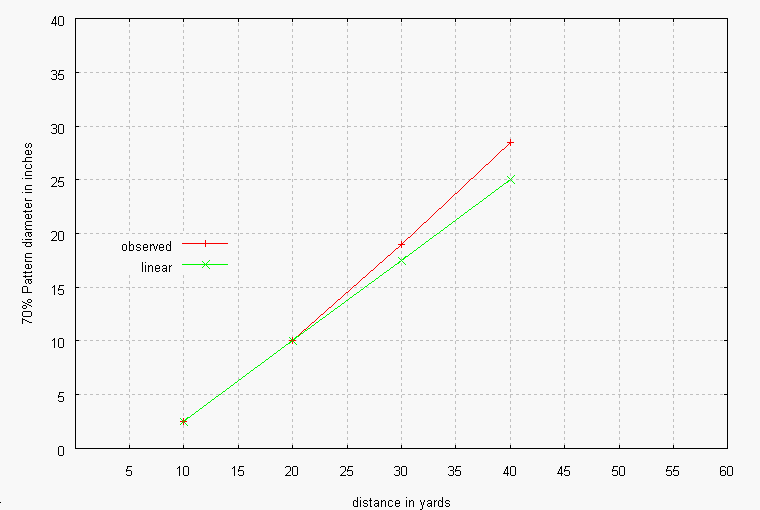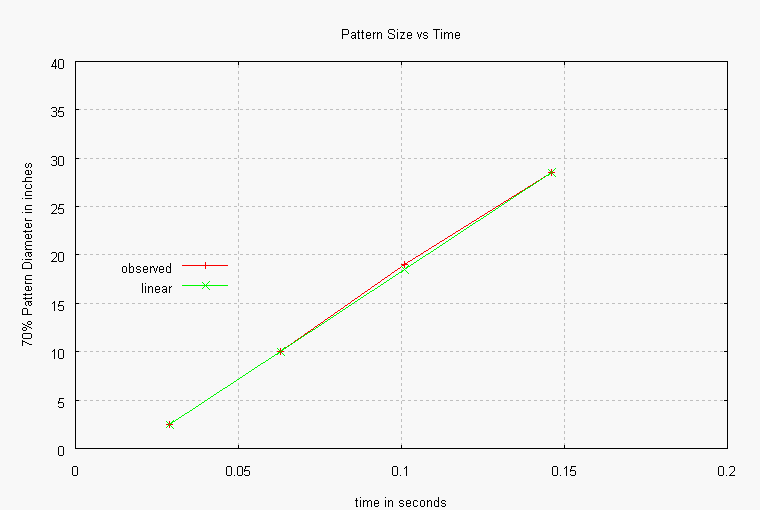Testing Method:
Most choke and pattern information use the 40 yard 30 inch circle as a reference point. Seventy percent of shot in a 30 inch circle is referred to as a Full choke, sixty percent being a Modified, fifty an Improved cylinder etc.
I will try to make my testing method consistent with this reference. Testing at 40 yards is difficult because of the distance. It usually must be carried out outdoors where wind, temperature and humidity cause pattern variation. The 30-inch pattern is large and difficult to work with. Shot outside the pattern is hard to catch and investigate and the center of the pattern is hard to identify.
The plan is to shoot at a shorter distance and then extrapolate my results to the 40-yard standard.
History:
Back in the early 70s after the military and before kids I did testing at various distances. It was in search of the same goal. Could I shoot at say ten yards and see what the pattern would look like at forty. I shot several tests at 10,20, 30 and 40 yards and tried to make a conclusion that would satisfy myself.
The results when plotted always showed a geometric spreading of the shot at each greater distance. This was contradictory to my hypothesis of a linear spread. There was something going on here that I could not explain, so on the shelf and on with life for 37 years.
Now that time permits I look at this once again.
Theory:
When a shot shell is fired, lots of pushing and shoving goes on just as the shot leaves the barrel. Before that point the charge is constrained by the walls of the barrel and the shot cup. As the shot leaves the barrel the forward component of the shot motion is basically set. Other bumping, shoving and unequal pushing causes an outward velocity component on each pellet. This outward velocity varies for each pellet and is what gives us the pattern spread. Theory would have it that once the pushing and shoving stops and the pellets quit interacting with each other, the forward and outward motions would not change except for outside forces acting on them (wind resistance and gravity). Other factors often mentioned such as flat and deformed shot have been greatly reduced by the modern hard shot and shot cups. These should have minimal influence.
Anyway, Theory would indicate that after the pushing and shoving has stopped the pattern should spread in a linear fashion and not geometric.
So it's time to go back to the drawing board.
Process:
Shoot several (at least 5) rounds at 10,20,30 and 40 yards and capture the resulting patterns. Find the center of each resulting pattern. Draw concentric circles outward around the center of the pattern until most of the pellets are included in the circles. Determine the diameter circle in which 70 percent of the pellets reside by counting the pellets out side the circles for short distances or inside for larger patterns. Record the diameters for each shot and then calculate an average 70 percent circle size for each distance.
Plot the resulting averages on a graph with circle size as the y-axis and distance as the x-axis.
With my gun test gun (Winchester 37, 32 inch .729 bore and swag choked to .690) and test shells (AA, 2 ¾ dram 8 shot shells) I get the following results.
Distance 70% pattern size
10 yard = 2.5 inch
20 yard = 10 inch
30 yard = 19 inch
40 yard = 28.5 inch
Plotting these I get a graph that looks like this:
If you have trouble seeing this graph click on the graph.

This still looks geometric which means that the resulting points get increasingly larger than a straight line. This again does not correlate with our linear assumption. The physics would indicate linear (straight line). So what’s up.
Maybe the theory is correct but our graphing is wrong.
The shot slows down the farther it travels due to air resistance. The forward motion being very fast (1150 f/s) will slow much faster than the outward motion which is relatively slow. I decided to plot the results with time as the x-axis instead of distance. The yardage distances can then be added latter at those times on the graph when the pellets reach that distance.
Using several ballistics programs and velocity/distance charts from various publications I calculated the following times for a 1150 f/s # 8 shot:
10 yard= .029 sec
20 yard= .063 sec
30 yard= .101 sec
40 yard= .146 sec
32 yard= .110 sec
14 yard= .042 sec
Using time as the x axis and then plotting the points (0.029,2.5),
(0.063,10),(0.101,19) and (0.146,28.5) give a graph as follows.
If you have trouble seeing this graph click on the graph.

This sure looks linear to me and verifies to my satisfaction the assumption of linearity. I justify the fact that the line goes below zero for short yardage to the fact that the interaction of the pellets (bumping and shoving while leaving the barrel) is not yet complete until about 7 yards. Beyond this distance very little additional outward velocity is imparted.
Now I feel confidant that I can use a 14-yard pattern to investigate differences in pattern size and shape between various shells. I can then extrapolate to other yardages using this relationship. However it will be hard to see pattern density for very tight patterns.
I choose 14 yards because I can fit the whole pattern on an 18 x 24-inch sheet of paper and can shoot in a sheltered controlled environment.
In other words it makes it easy for me!